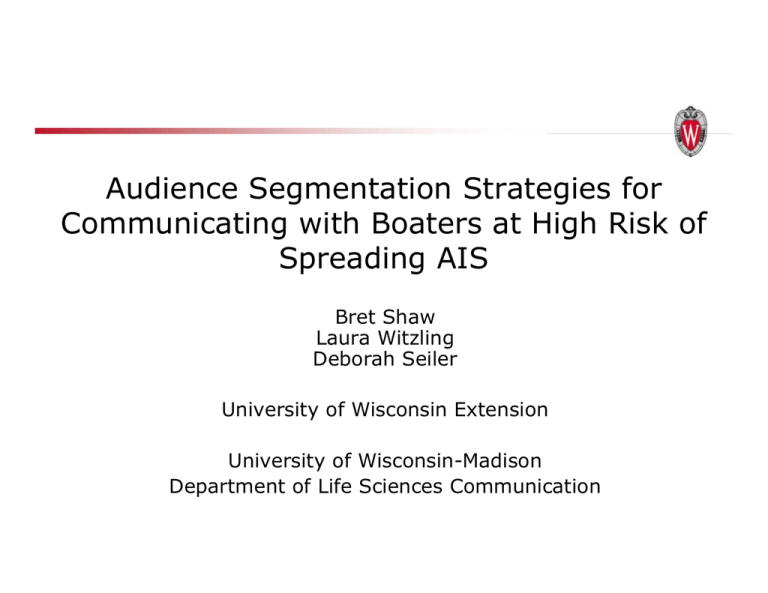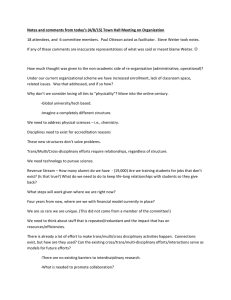Audience Segmentation Strategies for Communicating with Boaters at High Risk of
advertisement

Audience Segmentation Strategies for Communicating with Boaters at High Risk of Spreading AIS Bret Shaw Laura Witzling Deborah Seiler University of Wisconsin Extension University of Wisconsin-Madison Department of Life Sciences Communication Purpose Some boaters pose more risk to spreading AIS than others If high-risk boaters differ on factors that could inform communication strategies, may want to target outreach Background - Segmentation Divide population into groups more like each other than other segments Segment by gender, behavior, geography, etc. Differential responsiveness most crucial criterion Prioritize segments with highest response to marketing effort Background - Segmentation Pick categories that are actionable Transience level: Can be identified (with boater registration this could generate a targeted mailing list) Proxy for risk Proxy for stakeholder groups Research Question Will highly transient boaters differ from boaters who are low or no transience when it comes to variables that inform outreach, such as behavior, attitudes, social norms, perceived behavioral control, knowledge, information exposure, and demographics? 2013 Survey of WI Boaters Registered boaters 1500 mail surveys 869 returned Admin. by WI DNR Filters If people don’t fish, filtered out, leaving 556 cases Missing data – 337 cases remain (61%) Most survey items missing less than 6% More data missing where a behavioral question wouldn’t be applicable to some (e.g., bait disposal) Transience Level No transience: Did not use boat on 1+ body of water in 2013 (116 respondents) Low transience: Used boat on 1+ body of water in 2013, but not within a 5-day period (108 respondents) High Transience. Used boat on 1+ body of water in 2013 and within a 5-day period (n = 111) Demographics 97% male 99% white Mean age 56 Income closest to “$60,001 - $80,000” Education closest to “Some college, technical or trade school” Self-Reported Behavior Mean Low Trans High Trans KruskalWallis test (n = 108) (n = 113) statistic Mean Mean 4.8a 4.6a 4.0b 38.4*** 4.4a 4.7ab 4.9b 14.3* 4.2a 3.9ab 3.7b 8.3* 3.0 3.1 4.8 4.0a 3.6b 6.5* No Trans (n = 116) Do not use leftover bait on another water body Do remove plants Do not transport catch in water Do transport catch on ice 2.7 Do not add water to minnow container 3.7ab Attitude, Norms, PBC No differences between the 3 groups in attitude, norms, or perceived behavioral control (PBC) Attitude: 3.8 Norms: 3.6 PBC: Prefer to do the steps at home 2.6 Launch is dangerous 2.3 Launch is crowded 2.3 No time for the steps 2.2 Physically difficult 1.8 Knowledge No differences in self-reported knowledge (3.5 on average) Objective knowledge questions – the highly transient group scored better than the no trans group Some items scored low overall Knowledge Low High No Trans Trans Trans (n = 116) (n =108) (n =113) % correct 96.6 97.2 96.5 25.0 34.3 46.9 66.4 69.4 73.5 Use leftover minnows on the same water body 77.6 74.1 79.6 Keep fish from waters contain VHS 35.3 38.9 47.8 Leave landing with plants/animals attached to boat 94.0 96.3 98.2 Release minnows 82.8 93.5 94.7 Leave landing with catch in water Use leftover minnows on another water body after contact 51.7 61.1 56.6 74.1 78.7 74.3 Launch boat with plants/animals attached Use same boat on 1+ water w/o power wash or other disinfect Leave landing with water onboard (except bait buckets & drinking water) Information & Communication No Trans (n = 116) Mean Discussion family & friends 2.5a Boat launch volunteer 2.2a Other anglers 2.2 Other boaters 2.2 Bait shop staff 1.8 Signs 4.2a Media 2.1 Fishing clubs 2.1 Lake associations 2.7ab Kruskal Low Trans High Trans -Wallis (n = 108) (n = 113) test statistic Mean Mean 2.4a 2.8b 10.1** 2.4ab 2.6b 7.4* 2.1 2.4 5.7 2.0 2.2 2.5 1.7 1.8 .32 4.5b 4.6b 15.1** 2.2 2.1 0.2 2.0 2.3 3.3 2.3a 2.8b 7.2* Discussion - Highly Trans Group It’s encouraging that high trans boaters not perceive more barriers and scored better on objective knowledge items Areas to watch: Highly trans group more often reuses bait on different water bodies, and adds water to minnow containers Discussion - Knowledge The no trans group scored worse on knowledge – potential issue, not so much because of AIS spread but policy implications in terms of including them in management decisions Few get question about disinfection correct – a positive sign people think of this recommendation as law? Discussion - Communication Finding ways for such conversation to diffuse information about AIS rules (e.g., encouraging people to talk with highly transient boaters in their support networks) may be beneficial Partner with lake associations Targeted mailing Thank you! Bret Shaw - brshaw@wisc.edu





